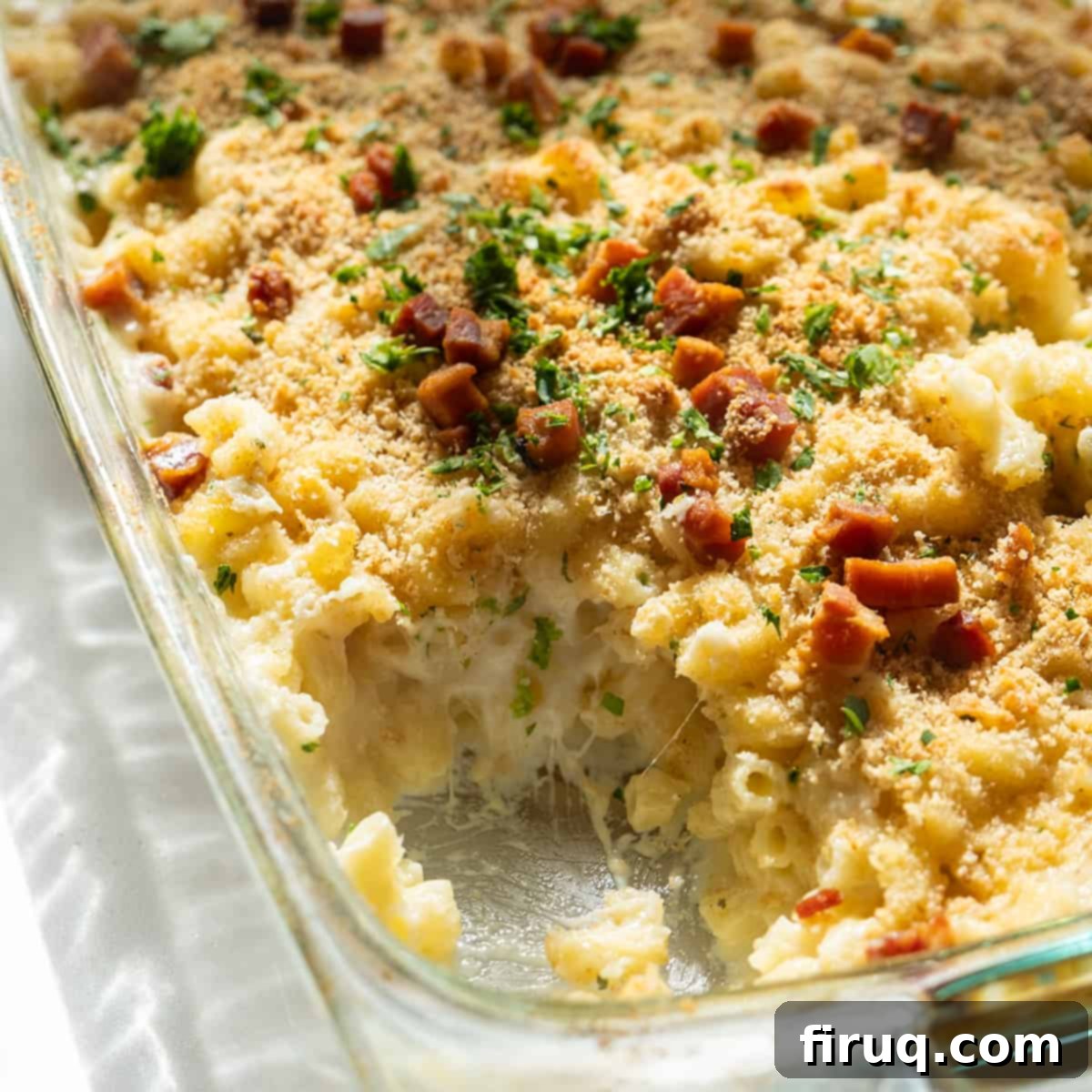The Ultimate Baked Italian Mac and Cheese: A Four-Cheese Extravaganza with Crispy Pancetta
Prepare for a culinary revelation with this extraordinary Italian Mac and Cheese. Far from your everyday comfort food, this recipe elevates the classic dish into a gourmet experience, combining four distinct Italian cheeses to create an incredible depth of flavor. Baked to golden perfection, each spoonful delivers a rich, creamy, and undeniably cheesy sensation that will quite literally “knock your socks off.” The experience is further enhanced with a tantalizing topping of savory pancetta and golden breadcrumbs, adding a delightful crunch and texture that makes every bite unforgettable.
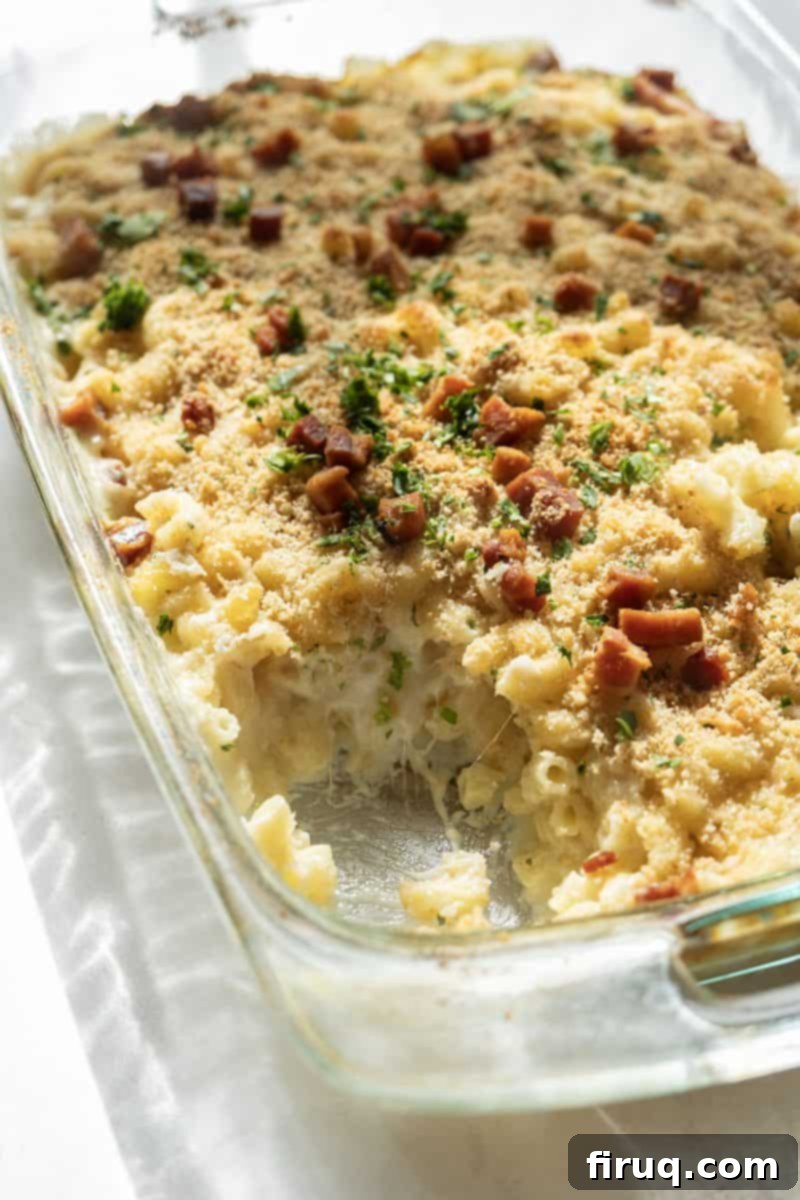
If you’re a devoted fan of macaroni and cheese and are constantly seeking exceptional side dishes, you’ll adore this Italian rendition. For more incredible pasta and risotto creations that complement any meal, be sure to explore our delightful Lemon Spinach Orzo and the incredibly indulgent Creamy Mushroom Truffle Risotto.
Jump to Recipe
Selecting the Best Italian Cheeses for Mac and Cheese
Throughout my life, I’ve had countless macaroni and cheese experiences – from the creamiest to the stringiest, the sharpest to the saltiest. Each variation possesses its own unique charm, and as my wife wisely puts it, “you never turn down any mac n cheese.” However, when crafting an authentic Italian version, the cheese selection becomes paramount. Many so-called “Italian mac and cheese” recipes surprisingly incorporate cheddar, a common denominator in traditional American mac and cheese. While delicious in its own right, cheddar doesn’t embody the true spirit of Italian flavors.
My goal was clear: to create a mac and cheese made exclusively with Italian cheeses that would offer a sophisticated, balanced, and truly authentic taste. After extensive recipe testing and experimenting with various quantities, I discovered the perfect blend of four Italian cheeses that deliver an unparalleled richness and texture:
- Provolone: Offers a delightful sharpness and a subtle pungent note, adding complexity.
- Mozzarella: Essential for that iconic, irresistible “cheese pull” and creamy melt.
- Parmesan: Contributes a deep, salty, and umami-rich flavor that enhances the entire dish.
- Fontina: A personal favorite for its exceptional creaminess, buttery texture, and earthy, mushroomy undertones.
Achieving the right balance is crucial. Too much of a single cheese, especially mozzarella, can lead to a mac and cheese that is excessively stringy rather than beautifully creamy. Our carefully chosen combination ensures a harmonious blend that melts perfectly, providing both a satisfying stretch and a luxurious sauce.
Detailed Ingredient Notes and Substitutions
Understanding each ingredient’s role is key to mastering this exceptional Italian mac and cheese. Here’s a closer look at what makes this recipe truly special:
Mozzarella: This classic Italian cheese was an obvious choice. It’s the star behind that captivating “cheese pull” everyone loves. Mozzarella is made using the ancient pasta filata process, where rennet is used to coagulate milk proteins into curds. These curds are then plunged into hot, salty water, which causes the protein chains to unravel and stretch, creating the elastic quality we adore. The curd is then skillfully stretched and compressed, giving us the familiar, delicious mozzarella that melts so beautifully. For the best results, use a low-moisture, shredded mozzarella.
Provolone: I wanted a cheese that brought a distinctive, slightly sharp, and perhaps even a hint of “stinky” character to the blend. Provolone perfectly fits this description, lending a robust, piquant flavor that cuts through the richness. If you prefer a slightly different profile, Asiago makes an excellent substitute, offering a similar sharpness but with a generally less pungent aroma, ideal for those who prefer a milder but still flavorful kick.
Fontina: This is a truly underrated cheese and one of my personal favorites. Fontina is incredibly versatile, known for its superb melting qualities. It imparts a wonderfully creamy texture and distinctive earthy, almost mushroomy notes to the sauce. It’s a key player in ensuring the mac and cheese achieves that luxurious, velvety consistency that coats every noodle.
Parmesan: The final cornerstone of our cheese quartet. While I’ve used domestic parmesan in this recipe, which still adds a fantastic salty and umami depth, feel free to use Parmigiano-Reggiano for an even more authentic flavor. Many “cheese snobs” might critique American parmesan, but my number one rule in the kitchen is simple: “there is no such thing as bad cheese.” What matters most is flavor and enjoyment. Parmesan contributes a necessary salty tang and a granular texture that rounds out the creaminess.
Pancetta: This cured Italian pork belly is integral to the Italian character of the dish. Its delicate, savory flavor and crispy texture when rendered are unmatched. While guanciale (cured pork jowl) would be an even more traditional and flavorful substitute if you can find it, I strongly recommend avoiding common bacon. Bacon’s smoky flavor, while delicious, tends to overpower the subtle nuances of the Italian cheeses and detracts from the authentic Italian feel of this recipe.
Macaroni Elbows: The classic choice for mac and cheese, their small, curved shape is perfect for holding the creamy sauce. You can also experiment with other small pasta shapes like ditalini or small shells.
Whole Milk: The base of our béchamel sauce. Whole milk is essential for achieving the richest, creamiest sauce. Lower-fat milks will result in a thinner, less luxurious consistency.
Butter and Flour: These two form the roux, the foundational thickener for our cheese sauce. Equal parts ensure a smooth, lump-free base.
Seasoned Breadcrumbs: Provide a crucial textural contrast. Seasoned breadcrumbs add an extra layer of flavor and create that irresistible golden, crispy topping when baked.
Fresh Parsley: A final garnish that brightens the dish with a fresh, herbaceous note and a pop of color.
Step-by-Step Directions to Italian Mac and Cheese Perfection
One of the most delightful elements of this Italian mac and cheese is the crunchy, salty bits of fried pancetta. Beyond the luxurious blend of four Italian cheeses, these crispy morsels truly burst with savory flavor, making every bite an experience.
Step 1: Render the Pancetta. Begin by dicing your pancetta into small ¼-inch squares. This ensures even cooking and crispiness. Place the chopped pancetta into a COLD PAN (this is crucial for even fat rendering) and then set the frying pan over medium heat. Fry the pancetta slowly and gently until it turns beautifully golden brown and crispy, which typically takes about six minutes. Once rendered, remove the crispy pancetta from the pan using a slotted spoon to drain excess grease and set it aside on a paper towel-lined plate. Carefully pour out most of the rendered pancetta fat from the pan, leaving just a thin coating if desired for flavor in subsequent steps, or clean the pan completely.
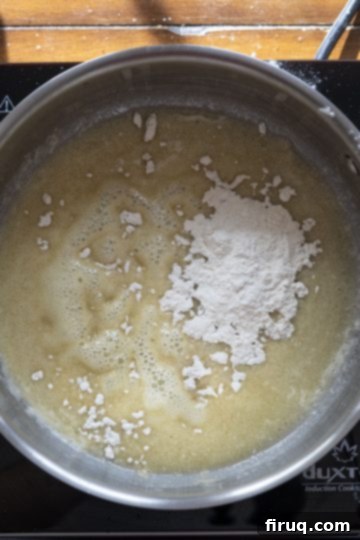
Step 2: Prepare the Roux. In a large, heavy-bottomed saucepan, melt the butter over medium heat. Stir continuously until the butter stops foaming, indicating that the water has evaporated. Once the foaming subsides, sprinkle in an equal amount of flour. Stir vigorously with a whisk to combine the butter and flour, creating a smooth paste known as a roux.
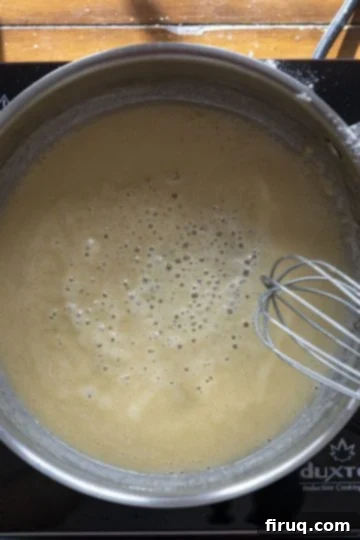
Step 3: Cook the Roux. Continue to whisk the butter and flour mixture for about 1-2 minutes until it becomes a light golden color and develops a nutty aroma. This cooking time helps remove the raw flour taste. The roux should be completely combined and resemble a thick, smooth paste, as shown in the image.
In parallel to making your cheese sauce, bring a large pot of salted water to a rolling boil. Preheat your oven to 400°F (200°C). Once the water is boiling rapidly, add a generous amount of salt (it should taste like the sea) and then add your pasta. Boil the pasta until it is al dente – firm to the bite, as it will continue to cook slightly in the oven. Strain the pasta immediately and set it aside, ensuring it remains warm while you finish the cheese sauce.
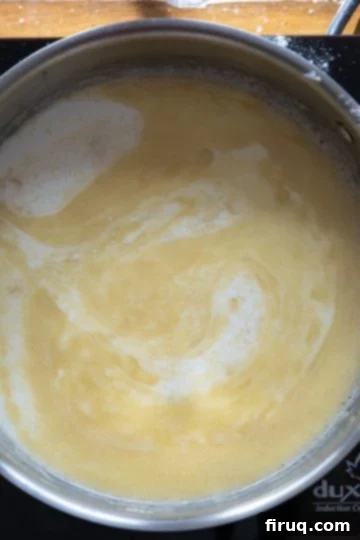
Step 4: Create the Béchamel. Gradually pour the cold whole milk into the roux, whisking continuously to prevent lumps. The cold milk helps prevent lumps as it slowly incorporates with the warm roux. Continue whisking until the mixture is smooth and evenly combined. Bring the milk mixture to a low simmer, stirring occasionally. It will begin to thicken as it heats.
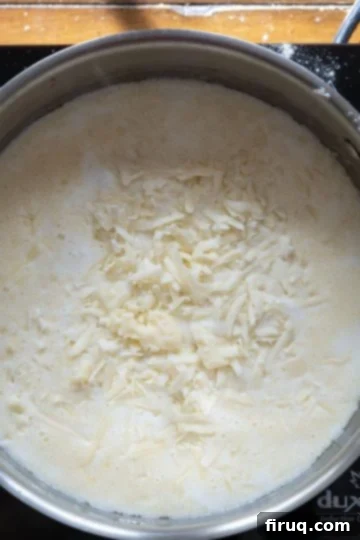
Step 5: Melt the Cheeses. Once the milk is simmering and slightly thickened, reduce the heat to low. Slowly begin to stir in all of your shredded Italian cheeses (Mozzarella, Provolone, Fontina, and half of the Parmesan). Add them in handfuls, stirring constantly until each addition is fully melted and incorporated into a smooth, luxurious cheese sauce. Make sure to save the remaining half of the Parmesan, as it will be sprinkled on top later for an extra layer of flavor and a beautiful golden crust.
Pro-Tips for Perfect Italian Mac and Cheese
- Timing is Everything for Pasta: For the best texture, aim to have your pasta finish boiling just after your cheese sauce is beautifully melted and ready. Mixing hot pasta with hot cheese sauce ensures maximum creaminess and prevents the pasta from getting cold and clumping. The pasta should be perfectly al dente, providing a pleasant bite even after baking.
- Start Pancetta in a Cold Pan: This is a crucial technique for achieving perfectly crispy pancetta. Adding pancetta to a cold pan and gradually heating it allows the fat to render slowly and evenly. This process results in beautifully crisp pancetta without any burnt, dry bits, and maximizes its savory flavor.
- Grate Your Own Cheese: While pre-shredded cheese is convenient, it often contains anti-caking agents that can affect how smoothly your cheese melts. For the creamiest, most luscious sauce, opt for blocks of cheese and grate them yourself. The difference in texture and flavor is noticeable.
- Don’t Overcook the Pasta: Since this is a baked mac and cheese, your pasta will continue to cook in the oven. Boiling it to just al dente, or even slightly under, will prevent it from becoming mushy after baking.
- Season Your Pasta Water: Always season your pasta water generously with salt. This is your first opportunity to infuse flavor directly into the pasta, making the entire dish more delicious.
- Choose the Right Baking Dish: A good quality ceramic or Pyrex dish will distribute heat evenly, ensuring a consistent bake and that signature bubbling cheese around the edges.
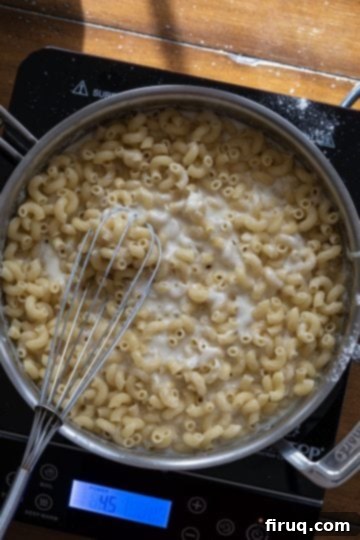
Step 6: Combine Pasta and Sauce. Carefully pour the hot, strained macaroni into your glorious Italian cheese mixture. Stir thoroughly to ensure every piece of pasta is generously coated in the rich, creamy sauce. At this stage, the cheese will still be delightfully stringy and stretchy – a completely normal and desirable characteristic! Fold in half of the crispy pancetta you prepared earlier, distributing it evenly throughout the pasta and cheese.
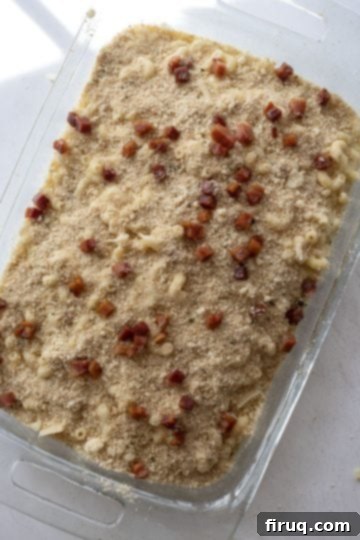
Step 7: Prepare for Baking. Transfer the combined macaroni and cheese mixture into a large, oven-safe baking dish (a Pyrex dish works wonderfully). Evenly spread the mixture. In a small bowl, combine the seasoned breadcrumbs with the remaining half of the Parmesan cheese. Sprinkle this mixture generously over the top of the mac and cheese, creating a golden crust. Finally, scatter the remaining crispy pancetta over the breadcrumb topping.
Step 8: Bake to Golden Perfection. Place your prepared mac and cheese in the preheated 400°F (200°C) oven and bake for approximately 20 minutes. You’ll know it’s ready when the topping is golden brown and the cheese sauce is bubbling enticingly around the edges of the dish. The aroma filling your kitchen will be irresistible!
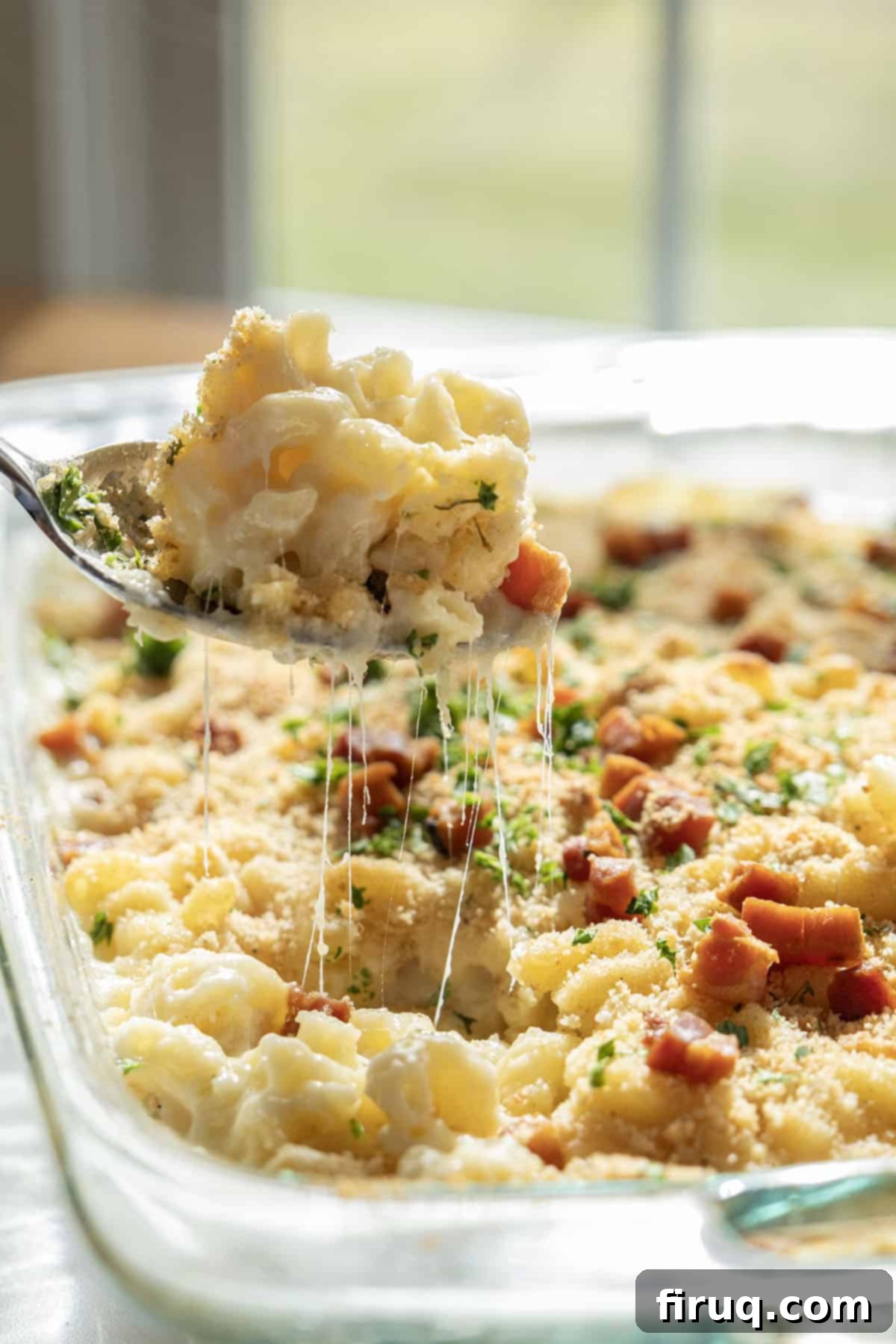
This is truly the perfect cheesy, robust, and authentic Italian mac and cheese you’ve been searching for. It’s the real deal, boasting a symphony of decadent, nutty, and savory flavors that will impress even the most discerning palate. The golden, crispy topping contrasts beautifully with the incredibly creamy interior, creating a textural masterpiece.
Beyond being an incredible main course, this dish serves as the perfect side for holiday gatherings like Thanksgiving, family dinners, or any special occasion. Its rich flavors and comforting appeal make it a crowd-pleaser. You can easily prepare this dish in advance, refrigerate it, and then bake it just before serving wherever the party takes you, ensuring a spectacular side dish that everyone will remember and rave about.
Frequently Asked Questions About Italian Mac and Cheese
For an unparalleled Italian mac and cheese, a blend is key. Fontina is a no-brainer for its exceptional creaminess and smooth melt without becoming overly stringy, and it adds lovely earthy notes. Mozzarella is indispensable for that desired “cheese pull” and gooey texture you see in viral videos. Parmesan brings a crucial salty and savory umami punch that elevates the entire dish. Finally, Provolone (or its close cousin Asiago) provides a delightful sharpness and a slightly pungent depth, adding complexity and a true Italian character to the cheese sauce.
It largely depends on the specific cheeses and desired texture. While some simpler cheddar-based mac and cheese recipes can be deliciously prepared stovetop, baking is highly recommended for an Italian mac and cheese that uses melting cheeses like mozzarella and provolone. Baking not only helps meld the flavors beautifully but also creates a delightful golden, crispy crust on top (especially with breadcrumbs and pancetta). Without baking, especially with mozzarella, the cheese can remain excessively stringy, making it harder to eat and less cohesive as a dish. Baking transforms it into a truly cohesive and decadent casserole.
To store, allow the mac and cheese to cool completely to room temperature. Then, transfer it to an airtight container and place it in the refrigerator. It will keep well for up to 4 days. For reheating, the microwave is your quickest option: heat in 1-minute intervals, stirring in between, until heated through. For a crispier topping, you can reheat portions in a preheated oven at 300°F (150°C) for about 15-20 minutes, or until bubbling, sometimes adding a splash of milk to restore creaminess.
Absolutely! This recipe is excellent for meal prep or entertaining. You can assemble the entire dish, including the topping, up to 24 hours in advance. Cover it tightly with plastic wrap or foil and refrigerate. When ready to bake, remove it from the refrigerator about 30 minutes before baking to allow it to come closer to room temperature. You might need to add an extra 5-10 minutes to the baking time if it’s going into the oven cold.
Traditional macaroni elbows are fantastic as their small, curved shape captures the creamy sauce perfectly. However, feel free to use other small, tubular, or shell-shaped pasta varieties like ditalini, small shells (conchiglie), or even orecchiette. The key is to choose a pasta that can hold a good amount of sauce and will cook evenly.
Perfect Pairings: What to Serve with Italian Mac and Cheese
This rich and creamy Italian Mac and Cheese is hearty enough to be a meal on its own, but it also shines as a luxurious side dish. Here are some fantastic pairing ideas:
- Chicken Dishes: The robust flavors of this mac and cheese pair beautifully with a variety of chicken preparations. Consider serving it alongside succulent Fennel Chicken Thighs braised in red wine, a perfectly seared Cast Iron Chicken Breast, or crispy, golden Italian Chicken Cutlets for a comforting and satisfying meal.
- Complementary Vegetables: To balance the richness of the ooey-gooey cheese, a fresh or vibrant vegetable side is a must. Options like sautéed Italian Lacinato Kale with garlic, tender Italian Cabbage, or the sweet and savory crunch of Maple Bacon Brussel Sprouts provide a refreshing contrast. A simple green salad with a light vinaigrette would also be excellent.
- Hearty Meats: This mac and cheese is a superb accompaniment to roasted pork, grilled steaks, or a classic Italian meatloaf.
Watch the Recipe: Video Tutorial
Explore More Cheesy Italian Pastas
If you love the rich, comforting flavors of cheesy Italian pasta, be sure to try these other delightful recipes:
- Pasta with Peas and Pancetta
- Pastina Carbonara
- Authentic Italian Baked Ziti
- Italian Stuffed Shells with Meat Sauce and Ricotta
Please leave a comment and star rating below in the recipe card! I love to hear what you think of our recipes and how they turn out for you. Feel free to tag us on Instagram @vindelgiudice when you share your delicious creations!
📖 Recipe
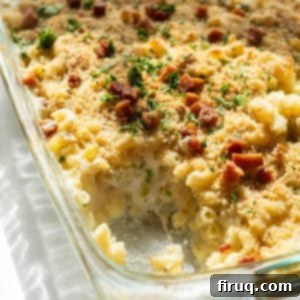
The Ultimate Baked Italian Mac and Cheese
Vincent DelGiudiceEquipment
-
1 large saucepan
-
1 large Pyrex baking dish (or similar oven-safe casserole dish)
Ingredients
- 12 oz macaroni elbows
- 8 oz shredded low-moisture mozzarella cheese
- 8 oz shredded fontina cheese
- 6 oz shredded provolone cheese
- 1 cup grated parmesan cheese (divided)
- 2 cups whole milk
- 6 tablespoons unsalted butter
- 6 tablespoons all-purpose flour
- ⅓ lb pancetta, finely chopped
- ¼ cup fresh parsley, chopped (for garnish)
- ¾ cup seasoned breadcrumbs
Instructions
-
Start by dicing the pancetta into ¼-inch small squares. Place the chopped pancetta into a COLD frying pan and place over medium heat. Fry slowly until the pancetta is golden brown and crispy, approximately six minutes. Remove the crispy pancetta with a slotted spoon to drain excess grease and set aside. Carefully discard most of the rendered fat from the pan.
-
Meanwhile, bring a large pot of generously salted water to a rolling boil. Preheat your oven to 400°F (200°C). Once boiling, add the macaroni and cook until al dente (firm to the bite). Strain the pasta and set it aside, ensuring it stays warm while you prepare the cheese sauce.
-
In a large saucepan over medium heat, melt the butter, stirring until the foaming subsides. Sprinkle in the flour, whisking continuously to create a smooth roux. Cook the roux for 1-2 minutes until lightly golden. Gradually pour in the whole milk, whisking vigorously to incorporate fully and prevent lumps. Bring the mixture to a low simmer, allowing it to thicken slightly.
-
Reduce the heat to low. Slowly add all the shredded mozzarella, fontina, provolone, and half of the grated parmesan cheese to the milk mixture, stirring constantly until all cheeses are completely melted and form a smooth, luscious sauce. (The sauce will be very stringy at this stage, which is perfectly normal.) Stir in half of the crispy pancetta. Then, add the warm, cooked macaroni to the cheese sauce and mix well until every noodle is coated.
-
Transfer the mac and cheese mixture into a large Pyrex baking dish. In a small bowl, combine the seasoned breadcrumbs with the remaining half of the parmesan cheese and sprinkle this mixture evenly over the pasta. Top with the remaining crispy pancetta. Bake in the preheated oven for 20 minutes, or until the topping is golden brown and the cheese sauce is bubbling around the edges. Garnish with fresh chopped parsley before serving.
Notes
-
- I like to make sure my pasta finishes boiling after my cheese is nice and melty and ready for the pasta. The pasta should be nice and hot when you mix it in with the cheese for optimal creaminess.
- Pancetta should always be cooked from a cold pan to a hot one. Adding it to a hot pan will result in uneven rendering of the fat and potentially burnt meat.
- For the best melt and flavor, consider grating your own blocks of cheese instead of using pre-shredded varieties.
- Do not overcook the pasta, as it will continue to cook slightly during the baking process. Al dente is perfect!
